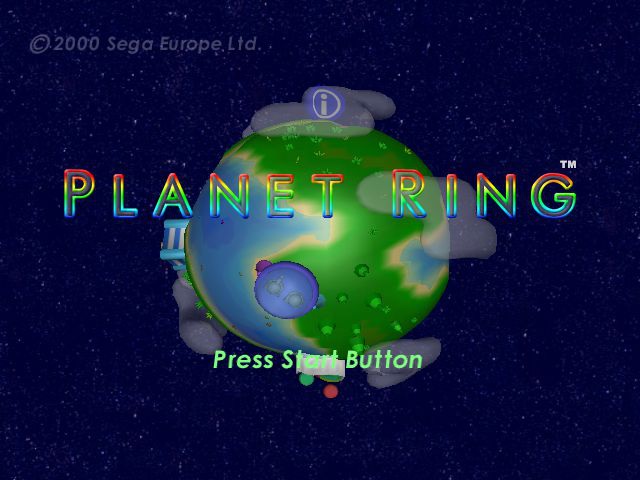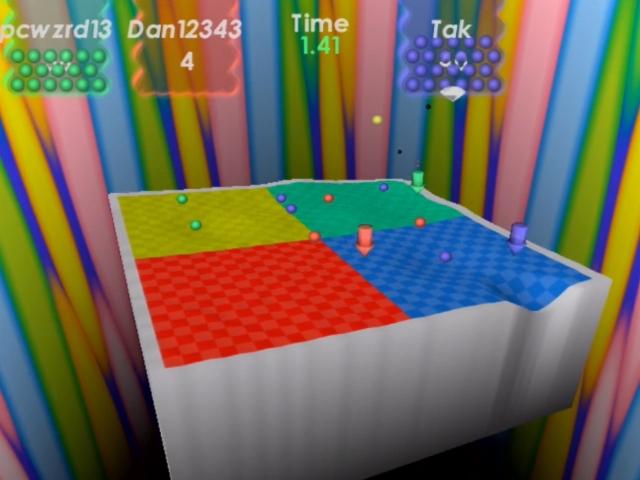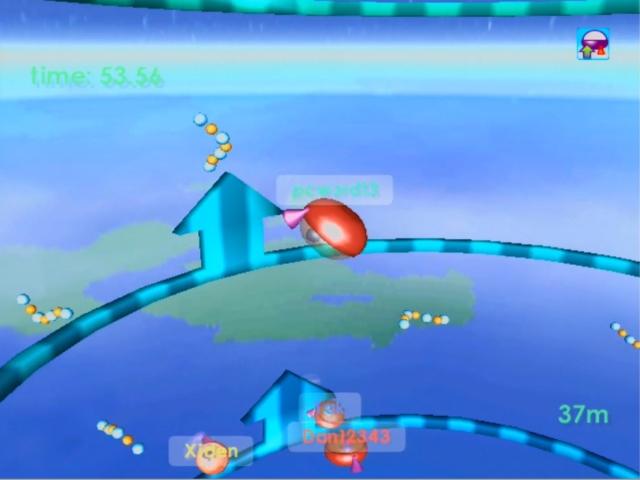
Planet Ring is one of the most unique and interesting games on the Dreamcast. Described as a “Online Theme Park”, Planet Ring was a collection of mini-games known as attractions that could be played online with players all throughout Europe. An online console game in 2000 was unique enough already but Planet Ring took this a step further by including voice chat; a first on Sega’s little gray box outside of Japan. Unlike Alien Front Online which claimed to have “real-time voice chat”, this was TRUE real-time voice chat and not just recorded voice clips.
Planet Ring was truly a showcase for what the Dreamcast could do when it came to online gaming. It had basically everything you’d expect in a modern online game: up to 8-player online multiplayer, voice chat, messaging, leaderboards, and even plans to add attractions through expansion discs (DLC?). I never had the pleasure of playing Planet Ring back when it was first released but I can imagine it was a mind-blowing experience for European gamers.
Now that you have a bit of background on the game, it’s time to get to the meat and potatoes of this article, an interview with one of the game’s programmers, Elton Bird, who was brains behind the crazy unique Ball Bubble attraction. Elton has been kind enough to give us some insight on the game’s origins and development. Without further adieu, let’s proceed with the inquiries!
Q: Let’s start off with a little bit of background on yourself. How did you come to work at Sega? Did you have any previous experience with game development?
“How I got to work at Sega would need an article on its own, but the brief version: I was emailing the Sega Europe Saturn News email address and my emails were answered by Mark Mazlowicz, who’s name I recognised as he dealt with the magazines. So stayed in regular contact and happened to mention I’d been programming stuff on the Amiga, and then out of the blue I get an email from the head of Developer Support at SoE, asking if I’d be interested in a role. Of course a chance to work as Sega was amazing, so I interviewed and got offered the job. My prior experience was a lot of half written demos, and 1 released full price game on the Amiga: Super Tennis Champs.”

Q: What was your role in the development of Planet Ring?
“I was one of 3 programmers, 2 original Support Engineers from SoE and Takuya Matsumoto (former Sonic Team) who’d come in to work with us. When the project was decided, we split off to do individual games for it individually, and I created Ball Bubble.”
Q: Planet Ring is certainly a very unique game. Can you tell me a bit about how it came to be? Where did the idea come from?
“I’m pretty sure the core idea came from Naohiko Hoshino, who was running European Product Development at the time. The name came from his love of Wagner’s Ring Cycle, considered to be his best work and being epic in scale. Hoshino-san wanted us to do something that would be our finest work too. Other ideas were mooted, but the online aspect, using Voice where possible and doing a kind of online Theme park, really solidified when Miyamoto-san joined as he’d already written a lot of Dream Dorobo.”

Q: How about your own mini game, Ball Bubble, where did the idea for that come from? I have to say, I’ve never played anything quite like it.
“Ball Bubble grew out of a couple of other demos I’d been playing with when Support work was light. I’d been trying to do a dynamic landscape that was fast, and decided to reuse it. Working out what to play on top of it took a few iterations. Being 4 player where possible was one of our goals, and originally it was target shooting with each player on the corner of the map, firing projectiles at targets while damaging the landscape. It wasn’t that engaging and the landscape didn’t affect the game much, so the next thing was to put the player on top of it and make them mobile. Capturing balls by manipulating the terrain seemed fairly obvious at that stage. The event pick ups were added to disrupt where possible and stop a player from dominating.”

Q: If I’m not mistaken, Planet Ring was the first console game ever to feature voice chat. How challenging was that to pull off?
“I imagine it was a tricky task, especially over a dial-up connection. The tech for that was something Sega had licensed I think, or worked on with a 3rd party in Japan, so the system was in place when we started, being fully implemented in Dream Dorobo.”
Q: What was the reason for some of the games not having voice chat? I’m guessing it was a technical limitation since only the two-player games featured it.
“It took quite a lot of performance out of the CPU to be able to use it, so I decided against it for Ball Bubble as it didn’t play too well at a low framerate, and probably had more game data going between players than the other games, and I’m not sure if 4 player would have worked.”
Q: Were there any plans to release Planet Ring outside of Europe or was it always a PAL exclusive?
“I think there would have been, especially Japan as the whole voice thing was something they started, but I’m not sure why that didn’t happen, probably just too close to the decision to stop supporting the Dreamcast.”
Q: Were there ever any plans for a sequel or was this just a one-off game? I heard that there were “update discs” planned that would add more attractions to the game. Can you tell me anything about that and maybe what new attractions were in the works?
“We were going to add more games, yes. But then they decided to drop Dreamcast and SoE cut all development, which was when I sadly left the company.”

Q: As I’m sure you’re aware, the game is now back online again thanks to some hardcore fans. What was your reaction when you first heard that the servers had been revived?
“I might have had a hand in getting it working again 🙂 (at least putting the guy in touch with people who knew about the server!) I think it’s great as otherwise the game was lost forever.”
Q: Lastly, what are you up to these days? Are you still a game developer?
“I’m still a games developer, yes. I went to Oxford to develop Racing games after Sega, then changed jobs to work on Nintendo DS at Exient, where I was involved in pretty much everything they did on the platform, most notably several versions of Madden and FIFA which all used my animation tech.
Since then I’ve worked mostly on iOS/Android. I did Jenga for Natural Motion, worked on Score and DLS at First Touch Games, did a few bits on Dawn of Titans back with NM.
I also started Uprising Games Limited and have been putting out my own iOS games too. Tennis Champs Returns being my latest.”
Q: Any chance you’ll develop a Dreamcast indie game one day? Maybe a spiritual successor to Planet Ring? 🙂
“I’ve thought about resurrecting Ball Bubble on mobile, but I’ve not done any homebrew Dreamcast (yet) as I’ve no idea what tools are out there. I wouldn’t rule it out :-)”
Some very interesting insight into the development of one of the most original games on the Dreamcast! A big thanks to Elton for taking the time to answer a few questions! Maybe one day we’ll see a new Dreamcast indie title from a genuine original Dreamcast developer! Go send him a Tweet @UprisingGames and let him know you want to see a port of Tennis Champs on the Dreamcast with online multiplayer and voice chat! 🙂

Interesting read!
Interesting read! Kinda wondering if games could still be added to planet ring today…. thatd be neat! Its a shame we never got to see dlc for planet ring though.
I’m guessing that games couldn’t really be “added”. The add-on discs would probably have been similar to the Pop’n Music games where you would have pseudo-sequels that are basically the same core game but with different content (i.e. attractions).